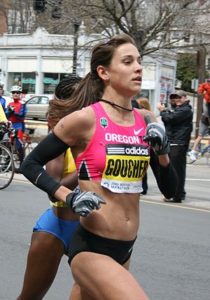How to increase speed has been a question asked since the first time people started training for sports. Weighted vest speed training is one key way to improve speed. But before investing time in weighted vest speed training it is important to know some tips on how to use your weight vest.
When to use a weight vest for speed
When should you use a weight vest for running? The answer might surprise you. Weight vests are used not only for sprint speed training, but also for improving speed on hills for endurance running and during warm-up to improve speed in a race.

Kara Goucher Trained for Marathon Hills with a Weight Vest
Weighted vest speed training is not just for sprinting. Alberto Salazar, Nike coach, famously took Kara Goucher and prepared her for the hills of her first marathon, the New York Marathon, by adding a weight vest for marathon training during hill repeats on her weekly long runs: “One of my workouts during the week was a hill session, every single week. And I finished all of my hard workouts and all of my long runs running uphill with a weight vest.” Kara Goucher interview for Runners World
Weighted vest speed training begins with the warm-up, according to published research on the benefits of using a weight vest before running. In a study, athletes did a warm-up consisting of a ten minute jog, followed by a five minute submaximal run to determine running economy, and finally by six ten second strides with a weight vest. The control group skipped the weight vest.
The results were impressive: “The weighted-vest condition resulted in a very-large enhancement of peak running speed (2.9%; 90% confidence limits ±0.8%), a moderate increase in leg stiffness (20.4%; ±4.2%) and a large improvement in running economy (6.0%; ±1.6%); there were also small-moderate clear reductions in cardiorespiratory measures. Relationships between change scores showed that changes in leg stiffness could explain all the improvements in performance and economy.”
How heavy should your weight vest be for speed training?
How heavy a weighted vest should you use for weighted vest speed training? Kara Goucher started with just a 5 pound weighted vest during the weekly hill repeats during marathon training and gradually added weight each week until she was using a 10 pound weight vest for marathon training.
For sprinters, researchers have looked at the ideal resistance level that should be applied when a weight vest is used for sprint training. They loaded athletes with different weights as a percentage of their bodyweight (0%, 8%, 15%, and 20% of body mass) and measured the effect on acceleration, maximum speed and time over a 50 meter run. They found that weighted vest resistance speed training using variable weights was ideal for sprint performance improvement:
External loads of 8 to 20% affected differently the selected distances of the speed curve. This observation is important since many coaches believe that the athletes should not use exercises with extra loading due to possible excessive changes in their running technique in or near the competitive season. From the results of the present study it is obvious that all loads seem to be useful for speed development according to the different phases of the speed curve but loads should be carefully applied to avoid fatigue. (KONSTANTINOS, ZAFEIROPOULOS & Smirniotoy, Athanasia & POLYXENI, ARGEITAKI & Paradisis, Giorgos & Tsolakis, Charilaos. (2014). Acute effects of different loading conditions using weighted vest on running performance. Biology of Exercise. 10. . 10.4127/jbe.2013.0073.)
Ready to train and need a weight vest? Learn more about the thinnest, best performing weight vest from Hyperwear.

Comments
0 comments
Please sign in to leave a comment.